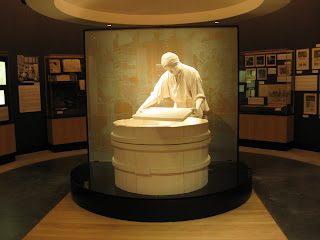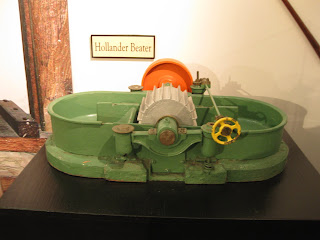Claudia is an expert on how to make many different kinds of paper. Along with western style papermaking, Claudia is teaching me Japanese papermaking. This is somewhat similar in principle in terms of sheet forming: the pulp is suspended in water in a vat, is pulled, couched and pressed.
However, there are big differences which will prove challenging. The fibers used are longer and have the ability to create translucent sheets, so the paper must be pulled very carefully and evenly (thin layer atop thin layer) by swishing the mould and deckle quickly back and forth. Formation aid, which makes the mould and deckle drain much more slowly, is key. Instead of the usual mould and deckle, this method requires a sugeta -which is a hinged mould and deckle with a bamboo screen and mesh screen in between. This tool is expensive and many papermakers make one with found parts. The thin sheets are couched together in layers rather than in between felts and they are not put into a press, but pressed by adding weight.
One fiber used in Japanese papermaking is Kozo. Japanese Kozo is very expensive, so Thai Kozo is a cost effective substitution (at 4$ a pound rather than 30$). The fibers come in a dried bundle and are very hard. They are boiled with sodium carbonate (soda ash-- in proportion to the amount of water used) until soft. They pull apart quickly along with the grain, but they should pull apart against the grain when they are fully cooked. Then the fibers are hand beaten using wooden mallets.
The kozo I ordered from Carriage house was extremely tough. It took
forever to boil. I am planning on boiling it again so I can assure it is fully cooked and hand beating it this week. (While we have been boiling fibers, we have been watching videos from the University of Iowa Center for the Book and I think Japanese papermaking is very intimidating after watching Timothy Barret's meticulous and authentic process.)
Claudia showing me her stainless steel turkey fryer which makes a great pot for boiling fiber:

Checking the kozo:

The fibers in the kozo lighten as they lose their gums and waxes, turning the water brown and leaving behind only pure cellulose fiber:















